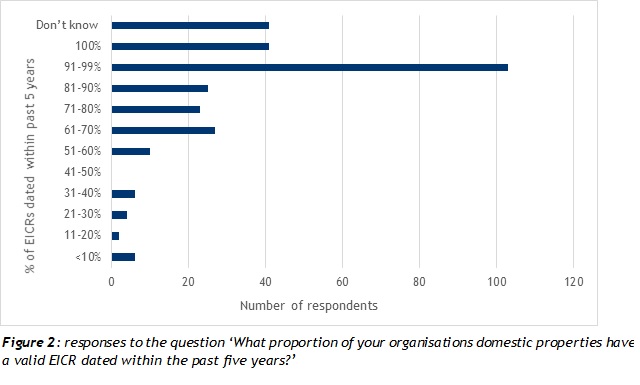Sign up to our newsletter
Historically, Pennington Choices’ property consultants have generally seen weaknesses across the sector with regards to the management of electrical safety. Despite providers increasing their focus on other areas of compliance, such as gas and fire safety, electrical safety is often found lower down the safety agenda.
Following the recent publication (January 2019) of the government backed Code of Practice for the Management of Electrotechnical Care in Social Housing, we believe that now is the opportune time to consider the position of domestic electrical safety within the social housing sector. Pennington Choices has partnered with Inside Housing and commissioned a survey to help understand and identify whether weaknesses and gaps are still present in the management of electrical safety. In doing so, we can raise awareness of significant issues to help housing leaders take appropriate action and implement any changes required.
The survey has now closed and the results have been collated. With thanks to 288 respondents, 82% of whom were either employed by a housing association or local authority, we now have an insight into the current arrangements providers have in place and the concerns around electrical safety. A number of recurring themes emerged from these responses which we examine below.
A legal requirement?
There are various pieces of legislation and regulation that outline providers’ obligations in respect of electrical safety in domestic properties, including; the Landlord and Tenant Act 1985, which requires electrical installations to be ‘safe when the tenancy begins and maintained in a safe condition’; the Health and Safety at Work Act 1974, which effectively requires providers to ensure tenants are not ‘exposed to risks to their health or safety’; and the Electricity at Work Regulations 1989. However, these are subject to interpretation as demonstrated by the disparity in the management and delivery of periodic electrical inspection programmes across the sector.
Thankfully, the new Code of Practice (CoP) provides definitive guidance that periodic electrical inspections should be undertaken at least every five years regardless of property type, which is welcome and helpful for providers that have previously deliberated over the frequency of their inspection programmes. The survey results show that many providers are moving to, or have already moved to, a five yearly periodic inspection regime from their previous ten year programme (or worse, where no programme existed). This is encouraging, however, 35% respondents say it will take more than two years, or they do not know how long it will take, to hold a valid EICR dated within five years for all of their organisation’s stock (as shown in Figure 1). This does suggest that there is some ambivalence around achieving what is considered good practice.
 Access denied
Access denied
A recurring theme and concern from the survey responses, is the lack of clear, legislative directive enabling providers to legally gain access to domestic properties to complete periodic electrical inspections, with one respondent articulating, “We need the support of legislation to enforce access in the same way as gas servicing”. Calls for electrical safety regulations to mirror gas safety regulations is also a common theme of the survey responses.
Many providers use current legislation (as described above) and provisions outlined in tenancy agreements to help them gain access which does have positive results, evidenced by the majority of respondents saying that 91-99% of their stock had a valid electrical installation condition report (EICR) dated within five years and 14% advising their organisation was 100% compliant. However, there are providers that do not have a robust access escalation processes in place, if there is one in place at all, with three respondents stating that less than 10% of their stock had a valid EICR dated within five years. Worryingly, 14% of respondents said that they did not know their organisations position on electrical safety.
 Regulatory breaches
Regulatory breaches
For the first time, in 2018 the Regulator of Social Housing found a provider in breach of the Home Standard in respect of electrical safety, due to failure to complete the remedial actions arising from electrical safety checks within a reasonable timeframe. The Regulator maintained that the provider had exposed its residents to significant risk for a prolonged period of time. The Regulator has stressed the importance of providers understanding all aspects of health and safety where tenants might be at risk, and not just the areas of compliance that are prominent (e.g. gas and fire safety).
We advocate providers engaging in dialogue with the regulator where there are significant safety concerns, and encouragingly 39 survey respondents say they have disclosed their organisation’s electrical safety position to the Regulator.
It is clear that the Regulator takes electrical safety seriously and providers should be prepared for scrutiny and action. To this end, it is imperative that Boards have a clear understanding of the organisation’s compliance position in respect of electrical safety (and all other property compliance areas). Boards are accountable for organisational health and safety and should be well-versed about their compliance position in order to make informed decisions around entering into dialogue with the Regulator.
Positively, the majority of respondents (53%) advised that to a large extent their organisation’s Board is familiar with the current electrical safety position. However, in our experience, some Boards are only familiar with the partial picture (usually dependent on the quality of data and information received from leaders and managers), and therefore the extent to which they are familiar varies greatly. Worryingly, six respondents say that their Boards were only aware to a very limited extent.
What next for electrical safety?
Pennington Choices’ Operations Director, Lee Woods says, “…the survey verifies what we see in our work, which is that there is still a long way to go until we can meaningfully say that as a sector we are aligned to best practice guidance.”
Lee’s comments reflect that electrical safety still has a tough hill to climb; the combination of difficult to access properties, providers not having a robust access procedure, and a general laissez faire approach to electrical safety within the sector, contribute to a number of providers not having effective systems in place to manage electrical safety.
Given the number of other priorities on the government’s agenda, it is unlikely that we will see any legislative changes around electrical safety in the near future. Therefore, it is imperative that the sector takes control for itself; electrical safety should not be seen just as a matter of legal compliance, but also a moral issue around safety.
If you would like any more information on the survey or you are concerned about how your organisation manages electrical safety and other areas of property compliance, then email Lee Woods to discuss how we can help you.





